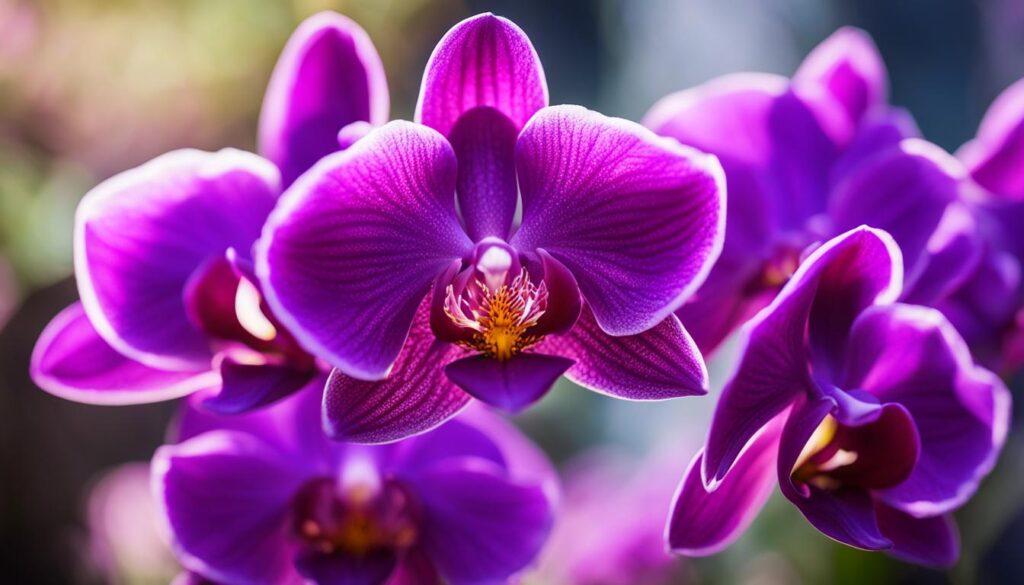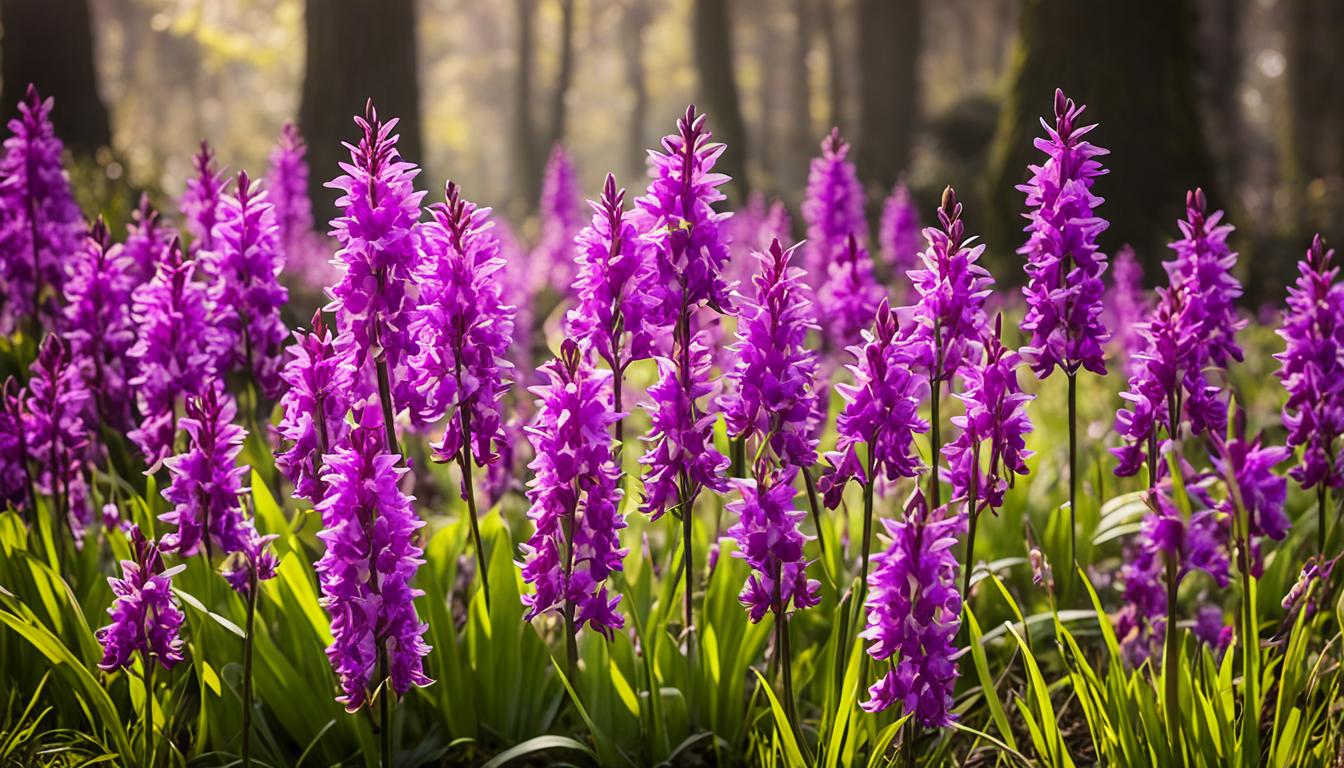Imagine a sea of vibrant blooms splashing the early spring landscape with a tapestry of color, surprisingly, in the UK alone, there can be as many as 30,000 sightings of the early purple orchid, Orchis mascula, each year.
These purple orchids are not just any exotic flowers, they’re a herald of spring, steeped in ancient woodlands and mythology, enchanting all who behold them with their resplendent beauty.
Known for their diverse orchid varieties, they add a touch of sophistication to any floral arrangements, embodying the quintessence of floral majesty.
As I delve into the vivid world of these orchids, I’ll be guiding you through their rich history, eminent cultural presence, and the varied species that make purple orchids a botanical jewel.
From royal gardens to quiet countryside lanes, whenever these exquisite blooms unravel their petals, an ethereal ambiance is inevitable.
As I unveil the secrets and subtleties of their existence, you’ll understand why purple orchids have captivated florists and plant enthusiasts alike.
Whether adorned in homes or creating lush woodland tapestries, their contributions to ambiance and aesthetics are undeniable.
Let’s explore these resplendent wonders and their place in nature’s grand design.
Key Takeaways
- Discover the myriad of purple orchid species that bring vibrant blooms to springtime woodlands.
- Uncover the cultural and historical significance of purple orchids in ancient mythology and modern floral artistry.
- Explore the wide range of purple orchid varieties, each with its unique characteristics and allure.
- Learn about the ideal conditions for these exotic flowers to thrive, enhancing your garden or floral arrangements.
- Gain insights into the symbolism of purple orchids and their influence in literature and folklore.
Understanding the Enchantment of Purple Orchids
As a seasoned horticulturist, I have always been bewitched by the allure of purple orchids, especially during the spring flowering season.
This enchanting flower has long thrived within the undisturbed serenity of ancient woodland, emerging as a herald of the vibrant spring.
The presence of these blooms adds immense wildlife value as they begin their captivating display, offering sustenance to various pollinators.
The Early Purple Orchid: A Springtime Marvel
In the awakening spring woods, the early purple orchid stands out with its majestic aura among the blossoming flora. Its purple hues are a spectacular sight, contributing to the rich tapestry of our ecosystem.
The orchid’s fragrance plays a pivotal role in attracting a host of industrious bees, which helps in the continuation of species through pollination – a process that surprisingly turns its scent into an unsavory one reminiscent of a tomcat.
My fascination with this characteristic reminds me of the bard’s – Shakespeare’s – musings, where he often wove petals and foliage into his literary tapestry with subtle Shakespearean references.
Symbolism and Cultural Relevance in Purple Orchids
The symbolism ingrained in the purple orchid is rich and varied, branching into different areas of culture and belief.
Reflecting on my review of classical stories and legends, I am reminded of how the orchid’s two tubers became rooted in Greek mythology, suggesting the influence on progeny.
Furthermore, Gaelic tales from the Scottish Highlands encapsulate this plant within the woven threads of love and hate.
Additionally, there are the religious connotations of the orchid’s leaf spots, believed by some to represent the blood of Christ, evoking deep reverence and contemplation.
Unique Color Variations of Purple Orchids
Exploring further, I am continuously amazed by the enchanting color variations found within purple orchids.
From the delicate flush of pinkish purple to the deep allure of bluish purple and the rare enigma of blackish purple, these plants are a true delight.
Whether it is in a carefully curated garden or the untamed wild, these colors remain consistent in their ability to captivate and fascinate onlookers, gardeners, and naturalists alike.
The myriad of shades ensures that purple orchids maintain an exalted position within natural displays and horticultural collections globally.
Top Purple Orchid Varieties for Indoor Gardening
Embracing the art of indoor gardening introduces a world of vibrant colors and elegant forms, especially when it involves popular houseplants like purple orchids.
Some varieties have become the pinnacle of home horticulture due to their captivating beauty and unique care requirements.
When selecting orchids for the purpose of enhancing your living space, the resplendent vanda orchids, the alluring dendrobium orchids, the charming phalaenopsis orchids, and the classic cattleya orchids stand out as ideal choices for the avid indoor gardener.
- Vanda Orchids: Known for their large, show-stopping flowers, this genus thrives in high-humidity conditions with ample airflow and bright light.
- Dendrobium Orchids: These orchids boast long-lasting flowers and adapt well to a variety of indoor conditions, making them a versatile option for home growers.
- Phalaenopsis Orchids: Often referred to as ‘moth orchids’, their ease of care makes them a favorite among beginners and professional indoor gardeners alike.
- Cattleya Orchids: Cherished for their fragrant and spectacular blooms, they require more specific care but are well worth the effort for striking floral displays.
Each of these exotic specimens demands attention to orchid care, including the provision of bright indirect light, consistent temperature ranges, and a vigilant watering routine, critical factors for sustaining their ornamental allure.
With proper attention, these orchids can transform any indoor setting into a tropical oasis.
Let’s delve into the particulars of their care:
| Variety | Lighting | Temperature (Day/Night) | Watering Frequency |
|---|---|---|---|
| Vanda Orchids | Bright, indirect light | 75-85°F / 65-75°F | Every few days |
| Dendrobium Orchids | Medium to bright light | 65-75°F / 55-65°F | Once a week |
| Phalaenopsis Orchids | Low to medium light | 65-80°F / 60-70°F | When the top inch of soil feels dry |
| Cattleya Orchids | Bright light with some direct sun | 70-85°F / 60-65°F | Once a week or biweekly |
Apart from their enticing beauty, navigating the intricate web of indoor gardening with these orchids can become a rewarding pastime that offers a sense of accomplishment with every new bloom.
And it’s not just about the nurturing, setting your home amid a collection of purple orchid varieties is akin to living within a personal micro-eden.

Maximizing Beauty: Flower Care Tips for Purple Orchids
For the passionate indoor gardener, nurturing the perfect environment for purple orchids translates into a showcase of luscious, vibrant blooms.
Understanding the subtleties of orchid care tips can make all the difference in cultivating these exotic beauties.
Creating a habitat that mirrors the natural conditions of orchids, involves precise lighting requirements, temperature control, attentive watering practices, and awareness of humidity levels.
Lighting and Temperature: Creating the Perfect Environment
A quintessential aspect of orchid care involves balancing the right amount of light and heat.
The ideal lighting for varieties such as phalaenopsis and cattleya is bright yet indirect, which can be typically achieved in a home setting near east-facing windows.
As for temperature control, sustaining daytime warmth between 70 to 80°F, with a modest dip at night, encourages optimal growth and maintains vibrant blooms.
Watering and Humidity: Keeping Your Orchids Thriving
Watering practices are central to a thriving orchid, with a mature orchid watering schedule consisting of weekly intervals, allowing the potting mix to dry slightly between waterings.
Meanwhile, humidity levels are equally pivotal; a brassavola orchid flourishes with 40 to 70% humidity, which can be maintained through the use of humidifiers or trays filled with water and pebbles placed beneath the plant’s pot.
Common Challenges in Growing Purple Orchids
Even with comprehensive orchid care tips, common challenges can arise in indoor gardening, requiring vigilance and adaptability.
Overwatering is a frequent misstep leading to root rot, while inadequate lighting may result in lackluster growth.
Regular monitoring and adjusting your care approach helps preserve the health and extend the bloom time of your striking purple orchids.

As I continue cultivating these enchanting flowers within my own home, detailed attention to each orchid’s specific care requirements ensures the prosperity of my indoor garden.
By embracing these flower care tips, our purple orchids are not just surviving, but thriving, brightening our living spaces with their dazzling allure.
Conclusion
Throughout this exploration of purple orchids, I’ve immersed myself in the world of these exotic varieties, each embodying an element of nature’s enchanting spell within our indoor gardens.
I’ve uncovered the essentials of indoor gardening, from selecting the ideal environment to mastering the art of flower care tips.
As a result, these vibrant blooms can transform our homes into a tapestry of captivating colors and indulgent scents.
These striking plants do more than just enhance the ambiance; they are storied emblems, rich in symbolism and cultural narratives that beautify not only our surroundings but also our collective history.
The versatility of purple orchids enables them to shine in elaborate floral arrangements or stand proudly as individual specimens.
Their presence is a daily reminder of the splendor that can grow from our attentive nurture and dedicated care.
In closing, my journey with purple orchids confirms that they are far more than mere decorative elements.
They are living artworks, organic testaments to beauty that flourish under precise conditions.
With the shared flower care tips done justice, these exotic flowers will continue to prosper and astonish, embodying the quintessence of indoor gardening at its finest.
FAQ
What distinguishes purple orchids from other orchid varieties?
Purple orchids, known for their exotic and vibrant blooms, offer a unique color palette that ranges from pinkish purple to deep bluish or blackish tones. They often hold significant symbolism and cultural relevance, adding depth beyond their visual beauty to floral arrangements and indoor gardens.
Where can the early purple orchid be found, and what is its ecological significance?
The early purple orchid, or Orchis mascula, is native to ancient woodlands, grasslands, and road verges across the UK. It plays a crucial role in ecosystems by being one of the first orchid species to flower in spring, providing early food sources for bees and other pollinating insects. Its appearance signals the beginning of the spring flowering season and adds to wildlife value in its native habitats.
How do mythology and symbolism relate to purple orchids?
Purple Orchids, particularly Orchis mascula, are steeped in mythology and symbolism. With roots in Greek mythology and Scottish Highlands folklore, they’ve been associated with love, hate, and fertility. The purple spots on their leaves also carry religious connotations, and they’ve had various uses in traditional cultures, including aphrodisiac properties.
What are some popular purple orchid varieties suitable for indoor gardening?
Among the popular purple orchid varieties for indoor gardening are the vanda orchids, which are known for their opulent blooms; dendrobium orchids, which offer striking appearances; phalaenopsis orchids, suitable for beginners due to their ease of care; and cattleya orchids, often used in corsages due to their gorgeous flowers and fragrance.
What are the ideal lighting and temperature conditions for growing purple orchids indoors?
Purple orchids such as phalaenopsis and cattleya thrive in bright but indirect light, typically found by east-facing windows. The ideal temperature range for most purple orchids is 70 to 80°F during the day and slightly cooler at night, which is crucial for their growth and bloom vibrancy.
How often should I water my purple orchids, and what humidity levels do they need?
Watering purple orchids should generally be done once per week when the soil feels dry to the touch, increasing frequency during periods of active growth. The humidity levels should ideally be between 40 to 70% for most purple orchids, with some varieties like brassavola needing higher humidity conditions.
What are some common challenges when growing purple orchids, and how can they be addressed?
Common challenges include overwatering, leading to root rot, insufficient light, causing leggy or weak growth, and improper humidity levels, which can stress the plants. Addressing these issues involves paying careful attention to each variety’s specific care needs and regularly monitoring the plants’ health to ensure they produce vibrant blooms.


Leave a Reply